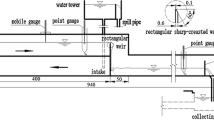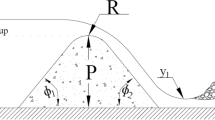Abstract
Circular-crested weirs have gained recognition for their high discharge coefficients in recent times. This study focuses on the experimental investigation of circular-crested weirs, specifically normal (ε = 0°) and oblique (ε = 30°) weirs, in a rectangular flume. The experiments were conducted under nine different flow conditions with progressively increasing discharge. Two distinct approaches were proposed to calculate the discharge coefficients for normal and oblique weirs during the gradual increase of flow discharge. In the flume, a flow with varying discharge rates was generated, and multiple discharge coefficients were considered at regular intervals. The first approach aimed to determine the instantaneous discharge coefficient of circular-crested weirs, while the second approach calculated the calibrated discharge coefficient for each flow condition. A comparative analysis of the findings from both approaches, conducted for each weir and flow condition, revealed that the average discharge coefficients obtained using the instantaneous method closely aligned with those derived from the calibrated method. Importantly, the discharge coefficients were determined without assuming dCd/dt = 0, thereby reducing inaccuracies compared to previous studies. The results indicated that increasing the weir angle in the channel, at a constant upstream flow depth, led to higher flow rates. Furthermore, this experimental study involved the calibration of the discharge coefficient for a 30º oblique crested weir, yielding a range of values between 0.52 and 1.07. Similarly, the discharge coefficient was calibrated for a normal crested weir, resulting in values ranging from 0.57 to 1.09.









Similar content being viewed by others
Abbreviations
- b :
-
Weir width (m)
- g :
-
Gravity acceleration (m2/s)
- H :
-
Height over the weir (m)
- h :
-
Upstream water height (m)
- P :
-
Weir height (m)
- R :
-
Weir radius (m)
- L :
-
Weir length (m)
- Q :
-
Flow discharge (m3/s)
- C d :
-
Discharge coefficient of oblique weir
- C D :
-
Discharge coefficient of normal weir
- Ɛ:
-
Weir angle in the channel (o)
- α :
-
The angle of the upstream side of the weir with respect to the vertical direction (o)
- β :
-
The angle of the downstream side of the weir with respect to the vertical direction (o)
References
Abhash A, Pandey KK (2021) Numerical study of discharge-head relationship of piano key weirs for low heads. Water Resour 48(2):235–244
Aichel OG (1953) Discharge ratio for oblique weirs. Z Ver Dtsch Ing 95(1):26–27 ([in German])
Al-Naely H, Al-Khafaji Z, Khassaf S (2018) Effect of opening holes on the hydraulic performance for crump weir. Int J Eng 31(12):2022–2027
Aydin I, Altan-Sakarya A, Sisman C (2011) Discharge formula for rectangular sharp-crested weirs. Flow Meas Instrum 22(2):144–151
Bagheri S, Heidarpour M (2010) Overflow characteristics of circular-crested weirs. J Hydraul Res 48(4):515–520
Baiamonte G (2021) Complex rating curves for sharp crested orifices and rectangular or triangular weirs under unsteady flow conditions. J Hydrol Eng 26(4):04021005
Bautista-Capetillo C, Robles O, Júnez-Ferreira H, Playán E (2014) Discharge coefficient analysis for triangular sharp-crested weirs using low-speed photographic technique. J Irrig Drain Eng 140(3):06013005
Bazaz A (2008) Discharge coefficient of weirs in unsteady flow. M. Sc. thesis. Graduate School of the University of Tehran
Bijankhan M, Di Stefano C, Ferro V (2018) Generalised stage–discharge relationship for rectangular weirs. Proc Inst Civ Eng Water Manag 171(3):125–133
Borghei SM, Vatannia Z, Ghodsian M, Jalili MR (2003) Oblique rectangular sharp-crested weir. Proc Inst Civ Eng Water Maritime Eng 156(2):185–191
Bortoni EC, Rocha MS, Rodrigues MA, Laurindo BC (2017) Calibration of weirs using unsteady flow. Flow Meas Instrum 57:73–77
Brakeni A, Filippov E, Meridja M (2019) Flow through Crump Weir. Larhyss J 2521–9782(38):93–102
Chanson H, Wang H (2013) Unsteady discharge calibration of a large V-notch weir. Flow Meas Instrum 29:19–24
Chanson H, Aoki S, Maruyama M (2002) Unsteady two-dimensional orifice flow: a large-size experimental investigation. J Hydraul Res 40(1):63–71
Crookston BM, Tullis B (2010) Labyrinth weirs. Hydraul Struct 59
Darvas LA (1971) Discussion of ‘Performance and design of labyrinth weirs.’ J Hydraul Div 97(8):1246–1251
DeCoursey DG, Blanchard BJ (1970) Flow analysis of large triangular weir. J Hydraul Div 96(7):1435–1454
Dias F, Keller JB, Vanden-Broeck JM (1988) Flows over rectangular weirs. Phys Fluids 31(8):2071–2076
Ferro V (2006) La sistemazione dei bacini idrografici-seconda edizione. MILANO, McGraw-Hill 1:1–848
Ghaderi A, Daneshfaraz R, Abbasi S, Abraham J (2020) Numerical analysis of the hydraulic characteristics of modified labyrinth weirs. Int J Energy Water Resourc 4(4):425–436
Ghasemzadeh F, Kouchakzadeh S, Belaud G (2020) Unsteady stage-discharge relationships for sharp-crested weirs. J Irrig Drain Eng 146(6):04020009
Hager WH (1985) Critical flow condition in open channel hydraulics. Acta Mech 54(3):157–179
Haghiabi AH (2012) Hydraulic characteristics of circular-crested weir based on dressler theory. Biosys Eng 112(4):328–334
Haghiabi AH, Mohammadzadeh-Habili J, Parsaie A (2018) Development of an evaluation method for velocity distribution over cylindrical weirs using doublet concept. Flow Meas Instrum 61:79–83
Haun S, Olsen NRB, Feurich R (2011) Numerical modeling of flow over trapezoidal broad-crested weir. Eng Appl Comput Fluid Mech 5(3):397–405
Hay N, Taylor G (1970) Performance and design of labyrinth weirs. J Hydraul Div 96(11):2337–2357
Hussien NJ (2014) Experimental study of height and surface roughness effects of crump weirs on over flow characteristics. J Univ Babylon 22(4):845–859
Izadinia E, Rismani N, Kabiri Samani AR (2017) Investigation on discharge coefficient of circular-crested weir using numerical modeling. J Hydraul 12(3):53–60
Kabiri Samani AR, Bagheri S (2014) Design of channels and water conveyance structures. Arkan-Danesh Publishing Co., Isfahan
Keller RJ (1989) Slo** crest crump weir. J Irrig Drain Eng 115(2):231–238
Khalil MF (2020) Quasi-steady state method for unsteady flow calibration of triangular weir. Alex Eng J 59(6):4139–4146
Kumar S, Ahmad Z, Mansoor T (2011) A new approach to improve the discharging capacity of sharp-crested triangular plan form weirs. Flow Meas Instrum 22(3):175–180
Kumar B, Kadia S, Ahmad Z (2019) Evaluation of discharge equations of the piano key weirs. Flow Meas Instrum 68:101577
Li S, Li G, Jiang D, Ning J (2020) Influence of auxiliary geometric parameters on discharge capacity of piano key weirs. Flow Meas Instrum 72:101719
Machiels O, Pirotton M, Pierre A, Dewals B, Erpicum S (2014) Experimental parametric study and design of piano key weirs. J Hydraul Res 52(3):326–335
Mohammadzadeh-Habili J, Heidarpour M, Afzalimehr H (2013) Hydraulic characteristics of a new weir entitled of quarter-circular-crested weir. Flow Meas Instrum 33:168–178
Niazkar M, Afzali SH (2018) Application of new hybrid method in develo** a new semicircular-weir discharge model. Alex Eng J 57(3):1741–1747
Parsaie A, Haghiabi AH (2019) The hydraulic investigation of circular-crested stepped spillway. Flow Meas Instrum 70:101624
Parsaie A, Haghiabi AH (2021) Uncertainty analysis of discharge coefficient of circular-crested weirs. Appl Water Sci 11:1–6
Parsaie A, Azamathulla HM, Haghiabi AH (2018) Prediction of discharge coefficient of cylindrical weir–gate using GMDH-PSO. ISH J Hydraul Eng 24(2):116–123
Ramamurthy AS, Vo N (1993) Characteristics of circular-crested weir. J Hydraul Eng 119(9):1055–1062
Sangsefidi Y, MacVicar B, Ghodsian M, Mehraein M, Torabi M, Savage BM (2019) Evaluation of flow characteristics in labyrinth weirs using response surface methodology. Flow Meas Instrum 69:101617
Sangsefidi Y, Tavakol-Davani H, Ghodsian M, Mehraein M, Zarei R (2021) Hydrodynamics and free-flow characteristics of piano key weirs with different plan shapes. Water 13(15):2108
Schmocker L, Halldórsdóttir BR, Hager WH (2011) Effect of weir face angles on circular-crested weir flow. J Hydraul Eng 137(6):637–643
Shamsi Z, Parsaie A, Haghiabi AH (2022) Optimum hydraulic design of cylindrical weirs. ISH J Hydraul Eng 28(sup1):86–90
Soulis KX, Dercas N (2012) Field calibration of weirs using partial volumetric flow measurements. J Irrig Drain Eng 138(5):481–484
Soydan Oksal NG, Akoz MS, Simsek O (2020) Numerical modelling of trapezoidal weir flow with RANS. LES DES Models Sādhanā 45(1):1–18
Vatankhah A, Khamisabadi M (2019) Stage-discharge relationship for triangular and curved-edge triangular weirs. Flow Meas Instrum 69:101609
Zerihun YT (2020) Free flow and discharge characteristics of trapezoidal-shaped weirs. Fluids 5(4):238
Zounemat-Kermani M, Ramezani-Charmahineh A, Kermani SG (2021) Studying the relationship between the hydraulic and geometry characteristics of labyrinth weirs based on the historical memory of reported data. Flow Meas Instrum 82:102079
Author information
Authors and Affiliations
Contributions
SMM helped in data curation, methodology, writing—original draft preparation. EI was involved in conceptualization, investigation, visualization, writing—review & editing, and supervision. AK helped in investigation, visualization, writing—review & editing.
Corresponding author
Ethics declarations
Conflict of interest
The authors declare that they have no known competing financial interests or personal relationships that could have appeared to influence the work reported in this paper.
Rights and permissions
Springer Nature or its licensor (e.g. a society or other partner) holds exclusive rights to this article under a publishing agreement with the author(s) or other rightsholder(s); author self-archiving of the accepted manuscript version of this article is solely governed by the terms of such publishing agreement and applicable law.
About this article
Cite this article
Mahdavi, S.M., Izadinia, E. & Khoshfetrat, A. Discharge Coefficient Calibrations of Normal and Oblique Circular-Crested Weirs Under Incremental Flow Conditions. Iran J Sci Technol Trans Civ Eng 48, 2679–2689 (2024). https://doi.org/10.1007/s40996-023-01277-6
Received:
Accepted:
Published:
Issue Date:
DOI: https://doi.org/10.1007/s40996-023-01277-6




